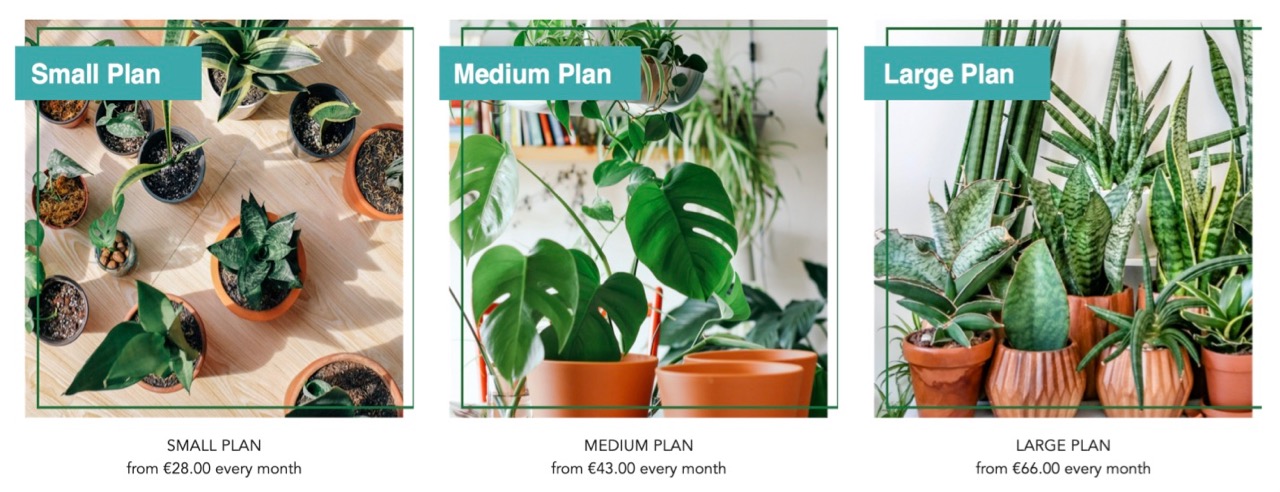Editor’s note: I’m writing this note four years after I’ve published this interview. Horticure no longer exists as a company, but I’ve decided to leave this post up to serve as inspiration for anyone who wants to start a plant rental business. I think Deborah shared useful insights that would prove very valuable to readers interested in this business model.
Have you ever thought about renting houseplants?
I’m not going to lie, the thought definitely crossed my mind four years ago, after yet another international move. My family’s life was in a period of transition, and my partner and I had no clue whether we’d stay put for more than a year.
It took a few months for the waters to settle, and in the meantime the only plant in our apartment was a store-bought sage, occasionally joined by a pot of basil whose only sin was not keeping up with the pace of pesto in our house.
In times like these, I would have loved to have the option to rent some houseplants. I wouldn’t have to deal with finding them new homes (always a sad process) if and when we had to uproot our lives and move again.
Luckily, houseplant renting services are no longer just for corporate clients with big budgets.
European startup Horticure is now at the forefront of offering plant rentals for individuals. I reached out to Horticure founder, Deborah Choi, to ask her a few questions about this new houseplant rental service.
Hi, Deborah. Can you tell us a bit about the plant services offered by Horticure?
Horticure is a young company and brand, launched at the end of 2018. In this short time, we’ve experimented with many different service models and products. For example, we previously piloted a program with a few independent plant stores, where Horticure was their marketing and logistics arm for online sales.
All through these iterations, we’ve kept the same mission: enabling more people to live a greener life indoors, by addressing the knowledge gaps, as well as the convenience and affordability issues that come with bringing plants indoors.
Plant rentals (or more specifically, a rent-to-own program for consumers), was a natural extension of our mission.
It took some time to get all the details right, such as building solid relationships with great and consistent growers, fine-tuning our logistics process and really understanding our customers’ pain points.

Who is your houseplant rental service for? Does your average plant renter have a profile?
What we see so far is that the Horticure customer is largely just getting started with indoor plants.
Generation-wise, they’re primarily millennials (between the ages of 25 and 40), rent their homes in urban areas with little to no outdoor space, and have a desire to feel good at home, with plants playing a new role in that.
How do you decide what plants to offer for rent?
We say with our plant rental program, “just add water”! Our focus is on plants that are easy to care for, but we hope to diversify the understanding of what an easy-care plant is.
So yes, we’ve got lovely Sansevierias, Monsteras and ZZ plants in our rental plans. But we’ve also included less well-known plant families that can thrive with normal room humidity levels and tolerate lower light conditions, such as Ctenanthes, Syngoniums, Philodendrons, etc.
We think easy-care also speaks to the maturity of the plant as well, so our kits only include plants that have already grown to heights of 15+ centimeters (about 6 inches), and fit planters no smaller than 14 centimeters (5.5 inches) in diameter.
Finally, our rental subscribers can pick our “Pet Friendly”, and enjoy between 15 and 40 diverse and non-toxic plants delivered to their home.

How does the plant renting process work?
We are currently piloting plant rentals in Berlin, Germany. But we plan to expand this service before the end of 2020 to a few more cities in Europe. Here’s how the process currently works:
Step 1: Customers select their package size (S, M, L), based on whether they’re filling a room or flat with plants. All plans include plants for hanging, setting on tables and window sills, and placing on available floor space.
Step 2: Customers decide the type of planter they want. We offer plants in either their nursery pots, or pre-potted in new terracotta planters.
Step 3: The customer also selects either our Classic mix, or the Pet Friendly plan (non toxic plants only).
Step 4: We then receive the plants and pots to our logistics center here in Berlin and re-pot the plants. This is done by our team of horticulturists, using peat-free and high quality soil plus substrate.
Step 5: Courier delivery is then organized to get all the plants in the kit (whether that’s 15 or 50!) to the customer’s home.
Step 6: Once a month, the customer has a short (10-15 minute) virtual check-in with a horticulturist on our team, as a way to help them grow their plant care knowledge, and also ensure any issues with the plants are handled right away.

What should someone who wants to rent a plant know before they sign up?
We’ve designed our rental program to be very flexible!
You can use it as a way to affordably bring plants into your home permanently via our rent-to-own option, or enjoy having a rotating selection of plants at home by opting to swap the selection every six months.
What happens if the renters fall in love with the plants?
We’re transparent about when the plants have been “paid off”; we hope you do fall in love with the plants and learn how to take care of them, with the support of our plant experts. Most plans are paid off after 6 or 7 months.
Renting plants for your home is certainly a very new concept, but we encourage people to give it a try with us!
Thank you for taking the time to join us, Deborah!

